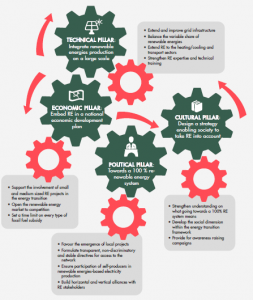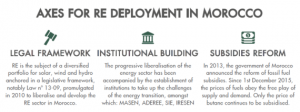Clean Technica
Guest Contributor
By Irene Garcia and Anna Leidreiter
At COP22, 48 countries committed to “strive to meet 100% domestic renewable energy production as rapidly as possible while working to end energy poverty, protect water and food security, taking into consideration national circumstances”. They are among the most vulnerable countries and are united as the Climate Vulnerable Forum (CVF).
With their declaration, these countries prove unique leadership in Marrakesh, keeping up to the promise to make the first COP after the Paris Agreement entering into force, an “Action COP”.
Morocco, the host country of COP22, is one of these 48 countries. Over the past months and years, the World Future Council has worked with several stakeholders in the country, developing a policy roadmap to transition to 100% Renewable Energy. With the CVF´s Marrakesh Vision, this roadmap can now serve as guidance for the new government to go faster and further and walk the talk.
A quick look back
In 2009, Morocco announced its goal to raise the share of renewable energies to 42% of its total installed capacity by 2020. And during the COP21, the government increased this to 52% by 2030: 20 % using solar energy, 20 % wind and 12 % hydro. To reach this goal, the country will develop additional electricity production capacity between 2016 and 2030 of around 10,000MW in renewable energies of which 4,560MW solar, 4,200MW wind and 1,330MW hydro.
These targets are anchored in a three-pronged strategy developed by the government to liberalize and boost the renewable energy sector in Morocco:
Policy changes resulted in success
The remodeling of the legal, institutional and financial framework has noticeably helped achieved impressive results in the diversified portfolio of renewable energy projects taking place in Morocco. A well-known example is Noor Ouarzazate, the first solar mega-project launched by the Moroccan solar energy agency (MASEN), will reach a total capacity of 580MW by 2018 and will bring power to 1.1 million people (learn more about it here). Or the Tarfaya’s wind park, with a production potential of 1,084GWh/year, is already supplying 1.5 million households and has become Africa’s largest wind energy project. The park has contributed to the creation of new road installations and equipment, and it has become a source of additional income for local communities by means of the business tax, apart from the development of local skills and capacities relating to wind energy.
Indeed, in Morocco renewable energy is not only a very important factor for the environment and the production of goods and services, but a key development vector as the following figures show:
And a closer look to Morocco’s wind and solar projects’ prices highlight the attractiveness of the country’s renewable energy plan. For instance, the country secured bid of Dh 0.72 (US$0.07 cents/Kwh) for the Tarfaya project and in 2016 set a new low for the Integrated Wind Project, securing a price of Dh 0.31 (US$ 0.03 cents/Kwh). This is well below the fuel fossils import price of 0.97 Dh (US$ 0.09 / Kwh) paid during the last ten years. Even for solar projects the price was also much lower than expected by MASEN, at Dh 1,5 (US$ 0.15 cents/KWh) for the first phase of the projects (NoorO I) and at Dh 1.4 (US$ 0.14 / KWh) for NoorO II and NoorO III.
Nevertheless, Morocco must go further and faster
If Morocco wants to solve the following challenges, it needs to go beyond current efforts.
Despite the avant-garde energy policy, a number of challenges remain in the way for unleashing Morocco’s incredible renewable energy potential. During round tables and interactive dialogues facilitated by the World Future Council in the past years, Moroccan policy-makers, experts and practitioners have identified numerous actions to set Morocco on a path to 100% Renewable Energy, foremost to prioritize renewable sources in the energy system and enable new actors to enter the market – both from a legislative as well as from a capacity perspective. This can only be achieved with a comprehensive approach, building on the following actions:
The World Future Council and all partners of the Global 100% RE Campaign congratulate Morocco for its leadership during COP22 and is committed to support the country in walking the talk.
To learn more about Morocco`s energy situation and potential pathways as well as to explore the proposed actions, read this report “Roadmap for 100% renewable in Morocco” (available in French and English).











